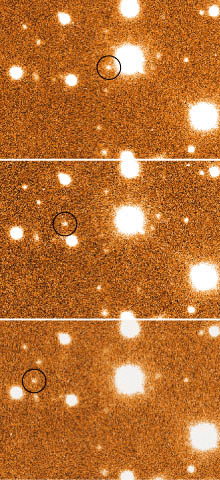Eleven new moons of Jupiter have been found by astronomers, bringing the tally of known satellites around the giant planet to 39 – more than any other planet. A team led by Scott Sheppard and David Jewitt of the University of Hawaii made the discovery using the 3.6-metre Canada-France-Hawaii telescope in Mauna Kea. The moons are thought to be fragments of a larger body that broke up after becoming trapped in the strong gravitational field of Jupiter during its early evolution.

Sheppard, Jewitt and colleagues imaged a wide area of the sky around Jupiter in December 2001, and then used computer algorithms to sift the images to identify possible satellites. To exclude rogue asteroids, the team monitored these candidates for several months using the 2.2-metre telescope at the University of Hawaii. Once the new satellites were identified, scientists at NASA’s Jet Propulsion Laboratory and the Minor Planet Center calculated their orbits.
Like most of Jupiter’s satellites, the new moons were found to follow highly eccentric – or elliptical – paths around Jupiter. They also orbit the planet in a retrograde motion, that is, in the opposite direction to the spin of the planet.
The researchers calculated that the orbits of the moons are clustered at a distance of about 20 million kilometres from Jupiter, which is about 300 times the planet’s radius. This suggests that they were formed by the break-up of a larger body, which astronomers believe could either have been a passing asteroid trapped by the early atmosphere of Jupiter, or a neighbouring planetesimal caught as the young planet rapidly aggregated material. Both of these processes would have taken place in the first million years of the solar system.
The Hawaii astronomers are not sure what the moons are made of, but assume that they are rocky bodies similar to asteroids. Based on earlier studies of asteroids – which reflect roughly 4% of the light that falls on them – the researchers calculated that the moons are between two and four kilometres in diameter.
The discovery was announced by the International Astronomical Union in its circular number 7900.



